Watchbury House Ownership 1788 - 1888
Greaves and Whitehead Families
Ken Hope
John Whitehead, a Warwick banker and property owner bought Watchbury from Samuel Cook in 1788 when it was known as Lodge Farm. On his death in 1845 it was passed to his daughter Mary and her husband John Greaves. After Mary’s death in 1864 it was acquired by one of her sons, Edward Greaves, After his death it was passed to Edward Seymour Greaves, the son of his brother Richard, He lived there until he moved away in 1888 and sold it to Francis Williams.
John Whitehead and Edward Greaves both made significant developments to the buildings and the associated estate during their ownership. These families owned and lived in other houses in Barford or elsewhere in the area so during much of this period Watchbury House was rented out,
Family Origins
The Whitehead Family
John Whitehead was born in Warwick in 1749. By 1791 he and other Warwick businessmen had founded a bank which was very successful during his years.
As well as being bankers, he and his family had invested in property around Stratford and Warwick, including some in Barford.
In 1776 he married Susana Hobson in Worcester and they had four children one of whom was named Mary.
He had a large house built opposite St Peter’s Church, Barford and called it The Red House. The house remained there until the 1960s by which time it had fallen into disrepair. The present houses on Verdon Place were built on the land.
The Whitehead family were members of the Society of Friends or Quakers, as were a few residents of Barford in earlier times. Their daughter, Mary Whitehead was a particularly devout Quaker as she grew up, This was demonstrated by her dress and in her way of talking according to an essay written by her daughter*.
The Greaves Family
In the late 1700s Richard and Rebecca Greaves and their son John Greaves moved from Moseley in Birmingham to Radford Semele. They were also members of the Society of Friends or Quakers,
The Whitehead and Greaves Families
John Greaves and Mary Whitehead were married. In a foreword to an essay ‘Reminiscences of The Greaves and Whitehead Families’* written around 1900 by Mary’s youngest daughter Mary Sophia, it was rather romantically suggested that ‘he fell in love with her, she in her charming dress walking on one side of the Avon at Barford and he on the other’. That may have been the case but they were married in the Society of Friends Meeting House in Warwick in November 1801.
As newly-weds they went to live in a large house just outside St Albans in Hertfordshire known as Pre Mill House. Whilst living there they started their family and during the next years their first three sons, Richard, Edward and John were born. They had a total of 14 children over the years. During this time Mary was reported to have left the Quakers.
In 1819 Mary Whitehead Greaves decided that she wanted her family to return to Barford. She was very apprehensive and fearful of the possibility of Napoleon Bonaparte invading England. As Mary Sophia wrote, ‘My Mother always kept £100 in gold in a secret drawer with which to escape to Barford in case of an invasion.’* It may have been that she didn’t want to be found living as a ‘better off’ family that might be targeted – probably remembering the fate of some wealthy French people with Madame Guillotine. Though Napoleon was exiled to St Helena in 1815 , she probably feared that as he had previously escaped from Elba, it could happen again.
One of the Barford properties which John Whitehead had invested in was Lodge Farm which later became known as Watchbury House. Around 1805 John Whitehead decided that it needed more living space so he added a large building at the rear. This brick built extension provided two large reception rooms on the ground floor with several bedrooms above. It was a typical Regency style of architecture with the roof coming in behind a parapet; such as can still be seen on many buildings on Leamington Parade.
So John Whitehead let the young family live in the extended Watchbury House on the understanding that John Greaves ran the associated farm.
Their youngest daughter Mary Sophia Greaves was born there in 1824. John and Mary Greaves continued to live in there until 1832. In Mary Sophia’s ‘Reminiscences’* she tells of some of her experiences of growing up in that family and in that house. Her description of the Watchbury House in which she spent her first years was ‘a simple but long farmhouse with a frontage on Church Street and an open courtyard at the back’.
In this essay she implied that her father was not very successful as a farmer or as a businessman and he was having money difficulties. So after 1832 the family moved first to Edgbaston in Birmingham for a while and then later to Radford Semele.
(*Warwickshire Record Office – Refce. Z899/3)
Edward Greaves
Their second son Edward was sixteen when his parents moved back to Barford. He had caught the eye of grandfather John Whitehead, who gave him a job working in his bank.
It is likely that, as a family member, he was soon given a good position in the bank. He seems to have been recognised as a ‘natural’ businessman because in 1824 the bank name was changed to include the name ‘Greaves’.
Even though Edward had been born into a Quaker family, on 5th December 1824 he was baptised at St Peter’s Church, Barford in the presence of both of his parents. At that time, if one was to take up a public office it was still necessary to be a ‘communicating’ member of the Church of England, so he was already showing interest in such opportunities.
In 1828 Edward married a Barford widow named Ann Hobbins Ward. She was the owner of Avonside, Church Street, Barford, which had been her family home. She and Edward Greaves lived there after their marriage. They had no children.
John Whitehead died in 1829. His will is held by the Shakespeare Birthplace Trust and he left his share in the Bank and some of his property to the husband of his daughter Mary, Edward’s mother.
At its peak, the Bank of Greenway and Greaves was a prosperous one. It had a customer base of over two thousand, including some landed gentry. It operated over a much wider area than Warwick and with connection to a London bank. Their clients had come to trust the Bank over several generations. The other founder, Kelynge Greenway, died in 1855 and his nephew, also named Kelynge, took over his role.
In 1861 Edward Greaves had become concerned about how the business of the Bank was going and about some loans in particular. So, now aged 58, he decided to retire from the Bank. He accepted an Aston Park property worth £25,000 as equivalent to his share in the Bank. The bank continued to operate until the late 1880s when it failed.
Edward’s father, John Greaves, had died in 1848 after suffering from heart problems. Edward’s mother Mary died in 1864 and everything she owned was left to her sons. That year Edward bought out his brothers’ share of their mother’s inheritance, including the Watchbury estate, for £7133,
Other Interests
Over the years Edward Greaves had also become involved in a number of business, political and other interests in Warwick, Leamington and elsewhere.
Some of these were :-
* In November 1840 he was elected Mayor of Warwick. And there is an official Statement of Denial by Edward Greaves that, when Mayor of Warwick, he had not received any bribes in connection with his duties as Returning Officer for the borough.
* In April 1842 he qualified as a Justice of the Peace. There are reports of court cases where he served as the magistrate.
* Edward Greaves was an early employer of 14 year old Joseph Arch – as a ‘bird scarer’ – though Arch later claimed that he was being underpaid.
* He took part in meetings of potential and actual shareholders of the Warwickshire and London Railway Company in April 1845 and the Leamington to Stratford Railway Company in 1852. It was recorded that the Engineer for these companies was a Robert Stevenson, son of the more famous railway engineer George Stevenson.
* In December 1852 he was appointed Deputy Lord Lieutenant of the County
* Edward Greaves was one of the few local people chosen to officially greet Queen Victoria when she visited Leamington on 16th June 1858. His older brother Richard Greaves was Mayor of Warwick that year so they both would have been among the crowds who waited to see her.
An article in the Leamington Spa Courier of 19 June 1858 described in detail all the decorations put up to welcome her and the places that her party visited. Many people, including some Leamington school-children, were given time off school or work to see and to welcome her.
The Record Office holds the information that those Barford children who could not go to see the Queen were treated to plum cake, oranges and tea at a huge party at Edward Greaves’ house. He also sent up a balloon for their amusement. He still lived in Avonside at that time.
* In the 1860s until October 1866, Edward Greaves was the Treasurer of Warwickshire County Council.
* He became involved with local stone quarrying and with the slate industry in north Wales. His younger brother John Whitehead Greaves had developed a thriving slate quarrying business in north Wales. The Ffestiniog Railway in north Wales was used to transport the slate to the port from where it was shipped all over the world. His brother John also became Treasurer and later Chairman of the railway company.
* 1872 he was President of Warwick Museum
* Possibly the most significant of all his work for the community was that he was one of the two Members of Parliament for Warwick between 1852 and 1865 and from 1868 to 1874. There are some reports of some very aggressive behaviour during the electioneering. He was a Conservative and he served under such Prime Ministers as Palmerstone, Gladstone, the Earl of Aberdeen and the Earl of Derby. Some of the significant events during those years were the Crimean War and the Indian Mutiny. Among other changes, the franchise law was extended in 1859 so that most men, not just property owners, could vote in General Elections. However he was not recorded as making very many speeches during his days in Parliament. He certainly was not reported as being an active politician.
* And it seems that he found the time to attend most of the Charity Balls in Warwick over a long period. The advertisements for these in the local papers gave the names of the important and/or wealthy people who would attend to support the particular charity. Edward Greaves was usually among names such as Lord Leigh of Stoneleigh, the Earl of Warwick, Lady Willoughby de Brooke and her family, the Greville family and other local gentry and wealthy people. This was clearly to encourage people to attend in support of the particular causes and at the same time have a chance to meet these important people.
Many of the above items of information were gathered from the local papers of the period from 1850 to 1879. Mostly from The Warwick and Leamington Advertiser and The Leamington Spa Courier. In the 1850s Edward Greaves had over 100 entries in the more than 500 published editions of the local paper; an average of once a month. But during the 1860s he had over 300 entries.
The Watchbury House Second ‘Make-over’
By the end of the 1860s, Edward Greaves had acquired properties in Scotland and Wales and he still owned a number of local properties. Amongst these was Watchbury House and its estate of 18 cottages on more than 200 acres of Barford land.
He was possibly conscious of the status he had achieved, the company he was now keeping and the fine houses some of these people lived in.
It was said that he wanted to own the tallest house in Barford. So in 1871 he set out to make Watchbury House just that. At the same time he tried to make it one of the grandest local estates.
* To enhance the external appearance of the older part of Watchbury House as seen from Church Street, Greaves he had already commissioned some wood carving work to be done by Kendal and Wilcox. They were nationally famous Warwick woodcarvers who also did work in the Houses of Parliament and at Charlecote.
They added the relief carvings in spandrels with musicians in the side panels of the arched entrance porch. Below this are turned balusters on a riser of linen fold paneling. They also added the pierced bargeboards and an oriel bay window in the front and another at the west end. Invoices for some of this work, dated in the late 1860s and after are held by the Warwick Record Office.
* To satisfy this alleged desire for Watchbury House to be the tallest building in Barford he had the 1805 building modified – the one on the right in the photo. He had the parapet removed and the roof raised by about 20 feet. As can be seen the replacement roof has overhanging eaves. Dormer windows were set into the south aspect of this higher roof but without any formal accommodation behind; just beams and rafters. There is enough space for an apartment in there but there is no stairway to provide access.
The upper external brickwork at the rear of this building still shows evidence of this change, as does the inside of the roof space.
* While all the roof work was being done, Greaves had the traditional Georgian sash windows and some other older leaded ones at the front, altered to ‘Yorkshire sash’ windows, These are opened by sliding them sideways thus removing the need for cords and counterweights. This apparently was a fashion at the time as well as eliminating the need for maintenance of worn sash cords.
* In Mary Sophia’s paper she said that when she revisited the house in the 1880s, she saw that the fine Sienna marble fireplace which had been in one ‘reception’ room, had been moved to the other one. This fireplace is still in its new place which is now part of Little Watchbury. The fireplace in number 10 was replaced by a fine wooden Kendal and Wilcox one.
* A completely new building, the one on the left in the photo, was added on the south side or what we today call the ‘back’. This building closed off the original open courtyard area. Even today there is a courtyard between numbers 8 and 10 which is still open-to-the-sky. This new building also provided another entrance to Watchbury House. To commemorate this building there is a stone plaque set into the wall and dated 1871. Also displayed on this plaque is the Coat of Arms which Edward Greaves had acquired.
This 1871 two storey building houses a magnificent library furnished with a number of traditional bookcases or book cupboards. Also it has a wooden fireplace and a heavily carved door which were dated by an architectural antiquarian to be from the 1680s and which he believed originated in a Flemish building. There is bedroom accommodation above.
This building was not mentioned in the original Historic England listed building description. Historic England had to be contacted a couple of times with evidence and pictures before they would correct this (see notes at the end). They still have only allowed that there were ‘enlargements’ in 1871. Not that there was a completely new block built which closed off the courtyard.
* Edward Greaves’ reason for setting a new main entrance on the south side of Watchbury House was because in 1872 he bought the Longbridge Toll House on the Warwick to Stratford Road, about a mile away. He had it dismantled and re-assembled at the end of Church Lane, Barford. This is now also a listed building in its own right. It was moved there to create a Lodge for Watchbury House (see notes at the end). Some features, which matched those on the Church Street aspect of Watchbury House, were added to the newly located Lodge, for example the pierced bargeboards,
* Greaves had a wide gravel carriage drive laid across his land from the Lodge entrance to the new entrance on the south side of Watchbury House. The start is still visible at the entrance gate of the Lodge as it goes towards the far end of the garden. The section that ran alongside the high wall is now overgrown. A few sections near the house are still visible and have formal underground drainage. This drive would have enabled the carriages to stop in front of the new, but rather unimposing, entrance.
The carriage drive then continued to the south through his orchard and joined up again with its start near the Lodge.
* There is also a five foot high wall which runs alongside the public footpath for several hundred yards beyond the Lodge. This marked the southern boundary to the upgraded house and its grounds.
These are some of the other noteworthy changes:-
* At some time a single storey building was built onto the east end of the house. It added what I believe to have been a Billiard room and a Garden Room to Watchbury House. The former is now the dining room for Little Watchbury and is typically Victorian in appearance with oak window frames, oak door, oak arch and fireplace and an ornate plastered ceiling.
I believe there were double doors to access the garden room originally which were closed off at the time of the division into three dwellings. This room was reassigned as a garage and the doors on the south side were fixed and garage doors added to the east side. The garage retains the oak window frames similar to those in the ‘billiard room’.
* This single storey building has a large coal cellar below to provide for the many fireplaces which existed in the house after 1871. I believe this extension was built at the same time as the raising of the roof and the addition of the hanging tiles because it is so integrated into the 1871 changes to the 1805 building. I think there must be some evidence in the County Record Office but it has yet to be found.
However, Historic England are not yet convinced and will only allow that it was pre-1905. Their evidence is that the first Ordnance Survey map on which this part appears is dated 1905.
* The simple 1805 house cellars were extended to include a wine cellar with a number of wine ‘bins’. Some of the other cellars were also added or extended for various household functions.
* The Icehouse is in the spinney east of the single storey building and was probably originally built with the 1805 building. It was also upgraded at the same time as the billiard and garden rooms as evidenced by the materials used which were similar to those in the new coal cellar. There were some even later additions which seem as if they were made so that it could be used as an air raid shelter in WW2.
* Other nearby buildings such as the bakery, a coach house and various servants’ accommodations, were also built or extended in the late Victorian period.
The New Approach for Visitors Arriving at Watchbury House.
After the installation of The Lodge and the completion of all these enhancements, Edward Greaves’ visitors to Watchbury House would now arrive in their carriages along Church Lane, – behind St Peter’s Church – instead of along what was then Church Street and is now High Street.
They would be driven through the 4 acres of magnificent well designed and maintained gardens which they could admire from their carriages. There were some very fine specimen trees planted near The Lodge along the drive. For example, the Wellingtonia pine, the Chilean pine or Monkey Puzzle tree and a fine copper beech which would have been planted in the late 19th century are still standing. They then would have been driven past a large rose arbor, more than 50 feet square,. Some of the fine rambler roses were still alive in the late 20th century. Beyond these was a large orchard.
On arriving at Watchbury House they would have been shown into a large Victorian house with a fine drawing room, a morning or dining room, a library, a billiard room and a garden room. For those staying overnight there were a number of bedrooms up the grand staircase.
There were also quarters for the living-in staff. Nearby were a bakery, the Icehouse, the butler’s cottage. the gardener’s cottage, the coachman’s cottage, the coach house and other buildings.
Summary
In 1874, aged 71, he decided to retire as an MP so he didn’t put himself forward to stand at the general election that year.
Edward Greaves did not survive for very long to enjoy such grandeur that he had created. In fact one might wonder if he had many visitors to enjoy his new large ‘upgraded’ house. It might be considered churlish to question whether his attempt to create such an upmarket home might have been seen as unacceptable by the high-born families with whom he was now trying to socialise.
We don’t know why, but he decided to spend most of his retirement in the mansion that had built for him on his Glen Etive estate in Invercharnan, Argylleshire. He was improving the area by a massive tree planting programme of larch and scots pine.
He fell ill there in 1878 and his doctor suggested that his health might improve if he returned to Barford. He returned to Watchbury House but sadly he died here on 5th July 1879. He was buried in the family vault in St Peter’s Church. The Leamington Spa Courier of 12 July 1879 had an obituary of well over 30 column inches praising him and all the things he had done for Warwick.
Edward Seymour Greaves
As Edward Greaves had no children he had chosen to pass on Watchbury House and estate to the son of his younger brother John Whitehead Greaves who had developed the Welsh slate industry. Edward Seymour Greaves lived there for some time including at the time of the 1881 Census. He then decided to move to the south west and Watchbury was sold to Francis Williams in 1888.
Authors: Ken Hope and Ann McDermott: Barford Heritage Group December 2020
Historic England Listing Information in 2020
Listing number 307928
No 8 (West Watchbury), No 10 (Watchbury House), No 12 (Little Watchbury) (21.4.83) High Street (south side)
Large circa C17 timber-framed range (divided into three dwellings) with large early C19 additions at rear. C17 portion consists of one storey and attic, six-bay range, three with gables and one with a later gabled porch. Brick infill panels and stone plinth. Steeply pitched plain tile roof with gabled ends. All six gables have ornate C19 bargeboards. Two three- and two four-light casements at ground floor, also oriel bay window; at first floor two three- and two four-light casements, all with leaded panes. The gabled porch has ornate timber framing (herringbone and circles). The arched entrance to porch has relief carvings in spandrels and musicians in the side panels; below are turned balusters on a riser of linen-fold panelling. Two brick ridge chimney stacks each with four square shafts. Attached to rear of No 8 and at right angles, is an early C19 brick, two-storey, three-bay house. Attached to rear of Nos 10 and 12 is large early C19 brick house enlarged in early C20. Two storeys and attic. Early C20 addition attached to east of C17 portion, recessed 1.2m behind front wall of earlier part of No 12. Single storey fronting road in line with front wall of C17 portion is balustrade and lych gate under tiled roof.
This entry was subject to a Minor Amendment on 17 April 2018.
Listing number 1035239
BARFORD Church Lane No 17 (Barford Lodge, formerly Longbridge Toll House on the Warwick to Stratford Turnpike. 1843 by D G Squirehill of Leamington for the Turnpike Trust. Moved in 1872 to the present site as a lodge for Watchbury House. Brick, faced with painted render and elaborate mock decorative pattern timber framing in early C17 West Midlands style. Steeply pitched clay tile roof. All gables have pierced bargeboards and moulded pendants. Single storey, F-shaped plan of which the north gabled cross wing may be an addition of 1872. Gabled porch on east front with roof supported by two miniature Ionic columns carried on the backs of reclining lions. Two-light casement windows, each casement with a semicircular head, and set in timber surrounds with pilasters and relief carving in the spandrels. Two rendered brick chimney stacks each with two polygonal shafts.}

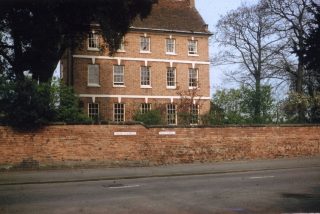


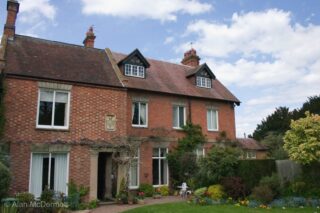
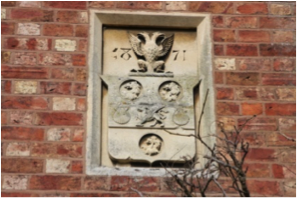
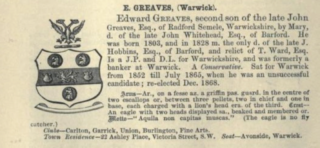


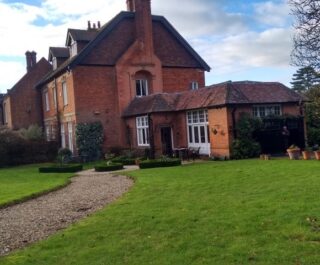
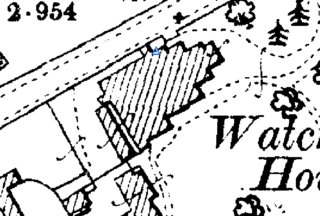




No Comments
Add a comment about this page